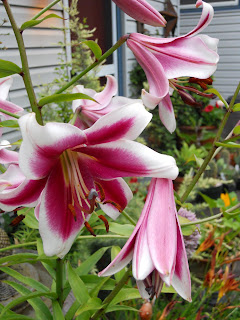
This is a tropical rhododendron that is growing in the store that has decided to bloom this week. Yes I said tropical, I had no idea myself.................Actually we have three others that are in the greenhouse, all planted in a 1 gallon pot or smaller. A pink one bloomed a few months ago and I forgot to take a photograph. Just Peachy has a tag in the pot that states it was propagated 8/19/02 and it is about 3 ft. tall.
First discovered in 1843 in the South Pacific, these plants are native to countries like Indonesia, Borneo and Malaysia. They are often found growing in rock crevices and in trees. This tropical is not really difficult to grow. The primary considerations are drainage and location. The correct exposure must be totally protected from wind and North side cold. A protected East exposure, or perhaps with a partial South exposure is required. Perfect drainage, high humidity, protection from direct sun, year around warm weather and good air circulation are the keys to happy plants.



















































